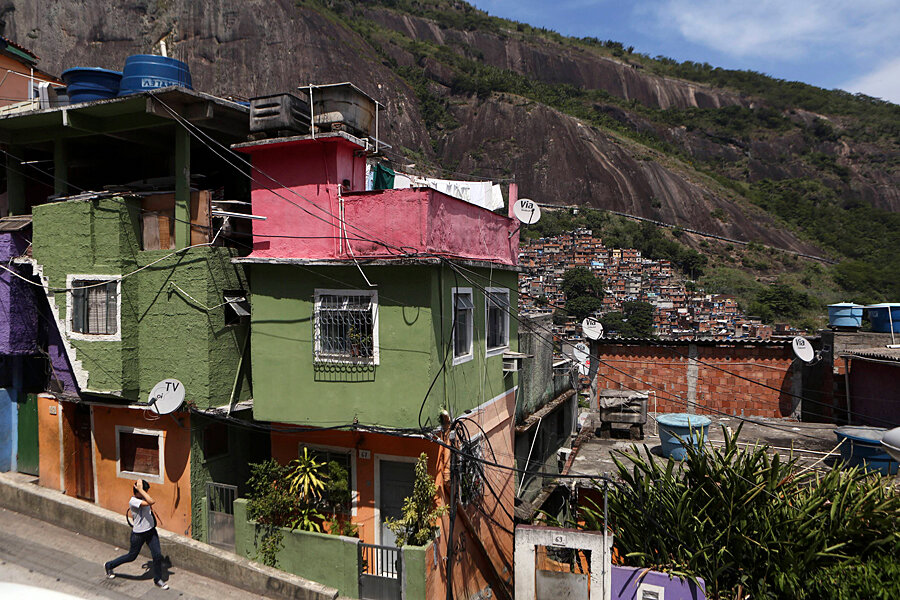From gunfights to 'mansions': Inside Rio de Janeiro's smorgasbord of favelas
| Rio de Janeiro
Turning the corner on a narrow, uneven footpath, a small white chapel comes into view in a plaza surrounded by whitewashed buildings with blue tile trim. As dusk falls on this tightly packed neighborhood set high above the ocean, the scene evokes Mediterranean Greece instead of one of Rio de Janeiro’s oldest favelas, Providência.
Brazil’s favelas, or shantytowns, are increasingly in the news, usually in a negative light. Last night the death of a popular dancer prompted a shootout between police and residents of Pavão-Pavãozinho, and protests spilled into the streets of posh Copacabana.
But not all favelas are created alike. There's Rio’s Cantagalo favela, where businessmen are moving in and building boutique hotels for tourists, and Complexo do Maré, which security forces recently occupied (it sits on a main road between Rio's airport and popular tourist zones.) In quickly gentrifying Vidigal, residents chatter about British soccer-star David Beckham's alleged "plans" to build a mansion among the homes perched on a steep mountain overlooking Rio's striking beaches.
“Favelas are built on central hillsides in Rio and hidden valleys in Sao Paulo.... Some are violent and dingy and others have homes selling for high prices. But they all have one thing in common,” says Pedro Da Luz, President of the Architecture Institute of Brazil in Rio de Janeiro. “Informality.”
Rio has 763 favelas, according to the 2010 census, home to about 22 percent of the city’s population, or nearly 1.4 million people. They’re unregulated and often defined by their lack of official access to public services like water, trash collection, sewage treatment, security, and electricity.
But they’re also innovative, and according to Mr. Da Luz, encapsulate a “truly Brazilian” quality of “preferring chaos over order.”
“It’s not a question of good or bad,” when it comes to favelas, Da Luz says. These communities are often solution oriented, which becomes obvious when walking up the steep stairway in Providência. Over one edge of the hand-built stone and concrete staircase there’s a single, large city water pipe with scores of smaller PVC plastic pipes siphoning off water to share among clusters of homes perched higher up.
Favela residents build incrementally and based on individual needs, Da Luz says, something made clear in the favela of Vila Kennedy, located on Rio's outskirts. The neighborhood was originally built in the 1960s by the US-funded Alliance for Progress as a grid of formal, low-income housing units. Now the flat land has been built up and out, adapting to the needs of residents.
But “there’s no respect for public space,” he says, citing what he considers a major problem. Favelas "lack a clear limit between the public and the private," which translates to few open spaces for neighbors to congregate and to pathways just wide enough for foot traffic.
Da Luz emphasizes the importance of “urbanizing” these informal zones: Connecting the neighborhoods to light, water, and sewage, and opening roads that can permit trash collection, and access for fire trucks, ambulances, and police cars. An estimated 60 percent of Rio’s sewage goes untreated into the city’s rivers and ocean, and disconnected favelas play a big role in this contamination, says Leona Deckelbaum, an activist who works on city sanitation at Meu Rio, or My Rio.
Urbanization could diminish the differences among Brazil’s favelas – and the stigma that exists between them and formal city neighborhoods, says De Luz.
“If we all pay the same taxes and get the same services, the second-class favela residents” can exercise their rights and help bridge Brazil’s vast inequality, Da Luz says. “It’s important for everyone to have a more inclusive city.”
He points to the recent police and security efforts in Rio to “pacify” violent favelas in the leadup to this summer’s World Cup and the 2016 Olympic games. “The most secure city isn’t one with the rich here and the poor over there,” he says. “It’s integrated.”
Whitney Eulich reported from Brazil as a fellow with the International Reporting Project (IRP).






